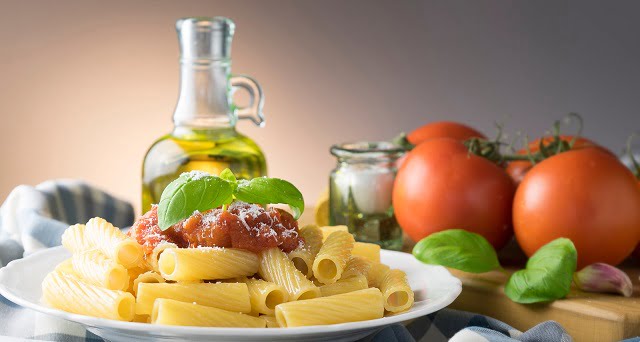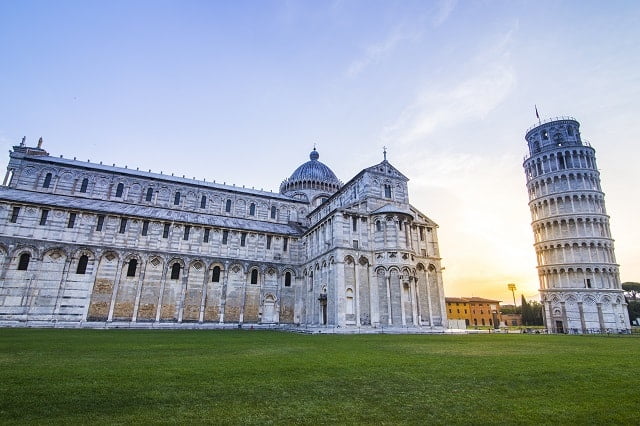
Italian lifestyle and cuisine can be said to be some of the most imaginative and theatrical types in the world. Each recipe has its own story to tell, often intricately connected to the culture, geography, history, and tradition of the region it was produced in.
This makes every Italian dish an exciting exploration of taste, emotion, and flavor. Every bite is unique as it transports you to a different place full of art and life that overflows with flavors that cannot be found anywhere else.
The foundation of Italian cuisine is based on simplicity. Its focus is on fresh, seasonal ingredients found right in the kitchen garden or sourced from local markets, freeing up chefs to experiment and develop elaborate signature dishes according to their creativity without having to rely on too many condiments.
When all its elements are brought together the results can be out of this world. From traditional recipes like Carbonara or Osso Bucco which feature simple but commanding flavors, it’s no wonder why they have stood the test of time for centuries.
The diversity of Italian cuisine is truly remarkable as every region showcases a range of dishes that present different textures and flavors that span across scales regardless of budget or season. Roman pizzas with thin crust that crackles in your mouth take inspiration from Apulia’s focaccia which features soft dough enhanced by oil rubbed garlic cloves while Sardinian Malloreddus provide bursts of intense flavor tied together by its subtle sage seasoning.
All these dishes have been perfected over hundreds of years through painstaking trial and error; helping define Italians’ dining experience till this day.
Whether it’s traditional Tuscan pasta served al dente with slices of truffle mushrooms sourced from nearby forests or Sicilian cannoli stuffed with cinnamon-laced ricotta cream-Italian cuisine always manages to surprise us with its unmistakable ingenuity. Eating isn’t just a way for Italians to satisfy their bodies but also a platform for them express emotion without words – something that becomes abundantly clear when comparing different dishes native to different parts regions within Italy.
Furthermore understanding what goes into creating an exceptional dish helps one better appreciate its exquisite quality every time it’s consumed or enjoyed during social gatherings such as family lunches or celebratory feasts.
Overview of Authentic Italian Ingredients and Techniques
Italy is famous for its culture, cuisine, art, and language. Its distinctive style has been widely embraced around the world. Authentic Italian cooking is not only tasty but incredibly healthy and satisfying at the same time.
It relies on the use of robust and quality ingredients to provide fresh, full-flavored dishes. When shopping for ingredients in an Italian kitchen, one should look for products that are locally grown whenever possible, as this increases flavor and nutritional value while helping to ensure food safety standards.
Italian Culinary Heritage
Italian cuisine has been influenced by several culinary cultures over its long history including Ancient Rome, North Africa, Greece, and France. As a result of these influences, many local dishes have developed throughout the country with each region boasting its own unique specialties like Italian pizza which originated from Naples and Basil Pesto which was developed in Genoa.
Furthermore, Italy has a strong tradition of pasta making that dates back centuries which today involves different shapes of pasta such as spaghetti or ravioli that can be served with various sauces like Alfredo or marinara. Italians also like to make use of fresh herbs such as oregano and basil which boosts flavor while introducing an intense aroma at the same time.
Helpful Tips
Here are a few tips for incorporating traditional Italian ingredients into your cooking:
- Locally sourced groceries should always be chosen above imported ones if possible.
- Italian olive oil is a staple in any kitchen as it adds flavor while providing essential nutrients.
- Fresh herbs should be added to all dishes for maximum taste appeal.
- Italian cured meats such as salami provide substantial amounts of protein.
- Cheeses like mozzarella or parmesan are key for making delicious Italian dishes.
Exploring Various Regional Representations of Italian Cuisine
The Italian lifestyle is famous for its abundance of quality food and wonderfully vibrant cultural elements. Both Italy’s stunning landscape and unique flavor combinations have made it an attractive destination for both culture-craving tourists and those looking to broaden their taste experience. Italian cuisine is heavily influenced by the different climates, regions and flavors from around the country.
From cheese-covered truffles in Piedmont, to zesty ciuciara sauces in Lazio, the vast palette of Italian food offers something to suit all palates. Here are three examples of iconic regional cuisine:
- Sicily – Sicily is home to some of Italy’s most delicious dishes, such as caponata, arancini and cannoli. Caponata is a Sicilian eggplant dish which uses fresh vegetables such as olives, celery and tomatoes for a rich yet tart flavor. Arancini are deep fried balls of risotto with a selection of fillings like mozzarella or ham, while cannoli are crisp shell pastries filled with sweetened cream cheese.
- Lombardy – Lombardy, located in Northern Italy, boasts dishes that draw on the variety of ingredients available throughout the region. Risotto allo zafferano is arguably one of Lombardy’s signatures dishes – a creamy rice dish flavored by saffron – while handmade trenette al pesto brings together fresh basil with garlic and Cascoino cheese for an indulgent meal.
- Veneto – The Veneto region includes two very well-known dishes – tiramisu and baccala mantecato (or creamy cod). Tiramisu is a delicious dessert made with Savoiardi cookies, espresso coffee and marscapone cream; baccala mantecato meanwhile has been eaten since Roman times due to its rich savoriness.
Italian cuisine also benefits from regional variations on more standard fare such as pizza recipes which vary by local ingredients added or topping combinations. Pizza margherita originally used only tomatoes, basil and mozzarella in honor of Queen Margherita who was visiting Naples at the time it was invented over 100 years ago.
Additionally classic pasta dishes such as spaghetti carbonara or lasagne vary between regions with subtle yet flavorful differences arising out of different traditions depending on where in Italy they hail from. Whether it be matchmaking over Tuscan ribon’fusciacavallo soup or learning how to make vitello tonnato in Piedmont there are so many traditional regional favorites just waiting to be experienced.
Embracing the Slow Food Movement in Italy
Italy, a country brimming in culture and history, is known all around the world for its exquisite cuisine. Italian food has its roots in tradition – homemade cooking utilized many simple ingredients to create mouth-watering dishes. In 1986, this traditional approach to food was taken to a new level with the launch of the Slow Food Movement. This movement focused on preserving local cuisine, honoring traditional recipes, and rejecting pervasive fast-food culture.
The Slow Food Movement has helped shape the current Italian lifestyle, fostering an appreciation of fresh and natural delicacies. Italians prioritize regional dishes rather than eating what is widely available; instead of buying mass produced food from grocery stores or popular chains, they stick to dishes from their local regions that are often prepared from scratch using locally sourced ingredients Many dedicated restaurants even pair these individual dishes with personally selected wines native to certain areas.
- The Slow Food Movement : Launched in 1986 as an opposite to “fast-food” and focuses on preserving local cuisine.
- Importance Of Regional Dishes: Emphasizes eating what is native to certain areas by utilizing fresh, locally sourced ingredients and making meals from scratch.
- Restaurants dedicate themselves : Emphasis put on pairing specific meals with regional wines.
In addition to being committed to local specialties rather than generic products, Italians strive for sustainability when it comes to their groceries. Farmers markets have become increasingly trendy over the last few decades because consumers choose not only excellent products but also unique stores that support small businesses. These incorporate traditional methods such as bartering rather than relying solely on money which is rooted in old Roman traditions.
The Slow Food ideology infiltrates all aspects of Italian life-family meals are events that bring loved ones together for hours attempting recipes passed down through generations with great care being taken in selecting quality ingredients. The latest trend toward pasta parties further demonstrate how communal sharing of meals is part of Italian Social Decorum-not only enjoying home cooked meals but also creating beautiful settings for safe gatherings among close affiliates.
- Supports Small Businesses : </Strong >Famers markets promote small businesses with traditional methods like bartering, rather than exclusively monetary transactions.
- Family Meals: </Strong >Spending quality time together while preparing recipes passed down through generations where emphasis laid on selecting quality ingredients.
- Pasta Parties:</Strong >A growing trend towards communal sharing which allow friends and family to come together safely over homemade pasta.
Feature Famous Celebrity Chefs to Cook Traditional Italian Dishes
Italy is a Mediterranean country renowned for its delicious cuisine, attractive scenery, and a culture of relaxing lifestyle experiences. The traditional Italian way of life has stood the test of time and can be experienced through restaurants that feature classic ingredients, world-famous spaghetti dishes, regional cuisine specialties, and the expertise of celebrity chefs.
Celebrity chefs are highly sought after when it comes to hosting Italian restaurants’ kitchen displays or catering events – making Italy a place to sample creative dishes made with fresh local produce. More than just delivering food to customers’ tables, celebrities offer their experience in preparing signature dishes like pasta-based meals and pizza pies alongside interactive activities such as cooking classes.
Famous Italian chefs bring a unique flavor to the table for customers who appreciate deliciousness while exploring some of Italy’s best menu choices:
- Antonio Carluccio – famous for his culinary career beginning in his long-running BBC television show named Two Greedy Italians.
- Gino D’Acampo – is an accomplished chef well known throughout England; he began appearing on British TV shows Today with Des & Mel in 2004.
- Lidia Bastianich – she runs several top Italian restaurants in New York City and is regarded as America’s foremost authority on Italian cuisine.
- Massimo Bottura – had much success through Osteria Francescana located in Modena, named World’s Best Restaurants 2019.
- Davide Oldani – known as the “Revolutionary Chef” by blending traditional flavors into new perspectives without compromising taste.
Popular Italian-inspired Cocktail Recipes
When you are looking for a delicious beverage to accompany an Italian-inspired meal or simply enjoy on its own, Italy offers a wide variety of signature cocktails. From Negroni’s and Spritzes to Americano’s and Margarita’s, here is a list of some popular Italian cocktail recipes:
- Negroni: A classic Italian cocktail made with equal parts of Campari, gin and sweet vermouth.
- Americano: A light and refreshing mix of Campari and sweet vermouth with soda water.
- Aperol Spritz: A unique combination of Aperol, prosecco wine, soda water and an orange slice.
- Margarita: An authentically Italian version of the classic Margarita made with limoncello liquor.
- Mimosa Rosa: An elegant mix of champagne or prosecco, limoncello liquor, sweet club soda and fresh fruit.
The Negroni is one of the most well-known Italian cocktails and it hails from the city of Florence. This sharp beverage is composed of Gin, Vermouth Rosso and Campari in equal measures. Refreshingly bitter with a beautiful amber hue, it can be enjoyed either on its own or paired with traditional pasta dishes such as lasagne. It is also possible to give it a modern twist by serving it over ice cubes infused with citrus zest.
The Americano serves as an interesting alternative to the Negroni which makes use of both Campari and Vermouth for a light alcohol ratio balanced out with sparkling soda water. As such it has become something of a summer favourite among Italians due to its cooling properties. Americanos are normally garnished with wedges or strips of lime peel making an attractive addition to any accompaniment dish or platter.
The Mimosa Rosa is another delicious beverage which adds a touch of elegance to any dinner occasion. This sparkling cocktail blends together champagne or prosecco along with Pink Limoncello for a refreshing Mediterranean feel. Pineapple juice can be added in as desired creating a charming pink colouration that helps enhance any appetising food options presented at the same time.
Health Benefits of Popular Italian Ingredients
Italian cuisine is internationally renowned and has a strong focus on the freshness of its ingredients. These amazing, yet simple, italian meals are packed with flavor, texture, and nutrients; as well as having many proven health benefits. Many of the popular Italian ingredients are core components of a healthy diet.
One of the most popular Italian ingredients is olive oil. Olive oil contains powerful antioxidants that can help reduce inflammation and support heart health. It is also considered to be one of the healthier saturated fats when compared to other types of oils.
A study conducted in Spain indicated a lower risk for cardiovascular disease among those who consume olive oil on a regular basis due to its monounsaturated fat content, which is known for improving cholesterol levels and protecting against high blood pressure. Research also suggests that olive oil helps improve digestion and may even help reduce the risk of certain types of cancers such as breast cancer due to its antioxidant properties.
Another widely used ingredient in various Italian dishes is tomatoes. Tomatoes can be found in sauces, soups and salads all throughout Italy; however, they possess more than just flavor and nutrition as they also contain lycopene – an antioxidant that can help protect from cancer, heart disease and stroke damage caused by free radicals.
Studies have shown that consuming lycopene-rich foods like tomatoes have been associated with decreased risks for certain diseases including prostate cancer, lung cancer and bladder cancer – making them a vital part of any healthy diet.
Finally, Parmesan cheese is an iconic symbol associated with famous Italian cuisine not only because it adds wonderful flavors but also because it provides several important minerals such as calcium, phosphorus, vitamin A and zinc.
Eating small amount of Parmesan cheese on a regular basis can provide much-needed calcium which helps strengthen bones and teeth while maintaining overall bone density – this makes Parmesan cheese particularly beneficial for women during menopause or postmenopausal age when your body’s hormones change which results in calcium loss over time through urination or sweat glands respiration etc.
Italian Lifestyle and Cuisine Around the Globe
When thinking of Italian lifestyle, people express an immediate thought of the grandeur and luxury associated with the country. From Venice to Rome, Italian cities offer amazing attractions such as breathtaking museums and galleries. In addition, in a trip to Italy, one may never forget its delightful cuisine with its signature flavours and aromas.
In all European cities one may find elements inspired by Italian lifestyle. There is an abundance of restaurants offering dishes comparable to those that can be found in Italy – freshly baked pizzas with mozzarella cheese; lasagna sheets layered with mouth-watering Bolognese sauce; delicious pastries like cannolis filled with sugar-coated ricotta cheese – all ingredients which reflect the flavours of ‘Bel Paese’ (beautiful country).
Whilst walking down lively streets and piazzas throughout Europe one can admire Vespas driving around ancient Roman monuments mingled in between modern skyscrapers – this defines today’s Italian culture; a contrast of history and modernity expressed through art, music, dance and fashion. Such harmony is also expressed through food according to regions.
The Northern part of Italy offers strong flavour combinations known more broadly as La Cucina Povenzale (Piedmont cuisine) which is most famous for its hearty stews flavoured with truffles – a rare delicacy prized by gastronomes worldwide. Classic dishes such as pesto originates from Genova region made from local basil combined with garlic, pine nuts, parmesan cheese and olive oil where the Southern region boasts extremely fresh seafood marinated in lemon juice characteristic from Sicilian cuisine.
Italian love for life shines through food, culture and tradition since thousands of years. It reminds people that genuinely experiencing life should invoke moments of happiness shared between friends or family members – amongst laughter over a pizza or flavored ice cream drenched in Nutella – classic Italian idea called Dolce Far Niente (the sweetness of doing nothing).
Italy radiates a unique atmosphere no other place but Italy has created – thoughtful architecture working upon perspectives; churches compete for glow during twilight hours conveying vastness when witnessed from afar while gondolas blending in poetic Giudecca waters evoke beauty at closer examination. This existence allows us to think bigger than ourselves hosting larger dreams into reality embedded images into our memories forever.




